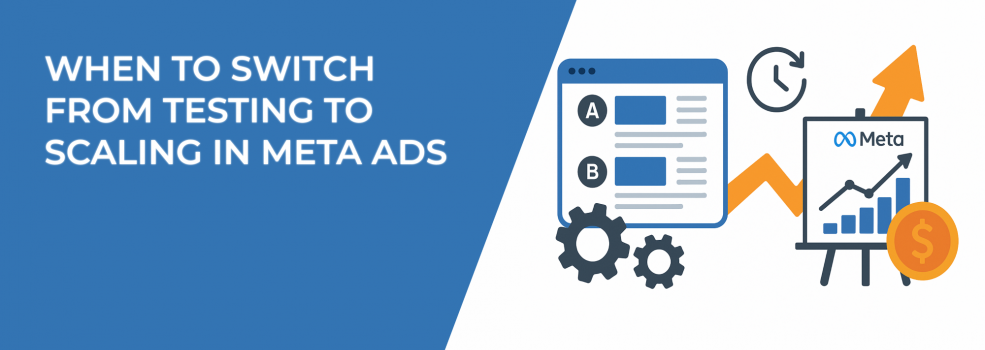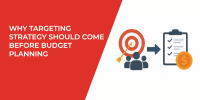Testing in Meta Ads is the launchpad of every winning campaign. Scaling is what turns those wins into real growth. But here’s the challenge: when do you know it’s time to switch from testing to scaling in Meta Ads? Move too fast, and you risk throwing money at unproven ads. Move too slow, and you leave profit and market share on the table.
The right moment to scale isn’t a guess. It’s a decision based on performance signals, budget efficiency, and a clear growth strategy. Let’s go deeper into how you can recognize the signs and scale with confidence.
1. Set Measurable Testing Benchmarks
Scaling decisions are only as strong as the foundation you lay during testing. Without clear benchmarks, you’ll never know if an ad is ready to handle a bigger budget.
Here’s what to define before testing begins:
-
Primary KPI: Decide whether you’re optimizing for cost per purchase, cost per lead, or ROAS.
-
Target threshold: Establish what an acceptable cost looks like for your business model.
-
Volume for validation: A small handful of conversions isn’t enough. Aim for at least 30–50 conversions per ad set before drawing conclusions.
Tip: Always calculate your break-even point first. If you’re selling a $50 product and your profit margin is $25, scaling only makes sense if your cost per conversion stays under $25 consistently.
If you’re not sure what to prioritize during early testing, check out this guide on key strategies for Facebook ad testing.
2. Wait for Algorithm Stability
During the learning phase, Meta Ads distributes impressions widely to collect performance data. This is where costs tend to fluctuate. If you scale too early, you may be scaling based on incomplete signals.
A good rule of thumb:
-
Let each ad set exit the learning phase (roughly 50 optimization events).
-
Monitor performance for at least 3–7 days of consistency before increasing budgets.
-
Don’t scale based on a single “lucky” day.
For more insight on how learning works, see our article on how to optimize Facebook campaigns for faster learning phase exit.
3. Check for Sustainable Performance
Stable performance doesn’t just mean hitting your cost targets once. It means maintaining them as spend increases slightly.
Watch these signals:
-
CTR (Click-Through Rate): A high CTR (above 1–1.5% for most niches) shows your creative is resonating.
-
Conversion Rate: If it remains strong even as impressions grow, you may be ready to scale.
-
Frequency: Costs often rise when frequency passes 2–3. If conversions stay healthy beyond that, your audience has room to expand.
Scaling without checking sustainability is like building a house on sand. Solid ground first, then expansion. You can also compare benchmarks with what’s a good CTR for Facebook ads in 2025.
4. Use Budget Increases Strategically
Scaling isn’t just dumping more money into a campaign. The way you increase spend affects whether Meta can keep delivering results.
Three common strategies:
-
Gradual budget increases — raise daily budgets by 15–30% every 3–4 days. Keeps algorithm stability intact.
-
Horizontal scaling — duplicate winning ad sets and spread budget across multiple audiences. Good for risk management.
-
Audience expansion — use broader targeting, higher lookalike percentages, or stack interests once a narrow audience shows promise.
Want more advanced tips? See the science of scaling Facebook ads without killing performance.
5. Don’t Scale Creatives Too Early
A common mistake is scaling just one creative because it “won” the test. But audiences fatigue faster than most advertisers expect.
Instead:
-
Scale with 2–3 strong creatives in rotation.
-
Keep testing new variations in the background.
-
Refresh ads every few weeks if performance dips.
If you suspect performance is slipping, learn how to identify and fix ad fatigue on Facebook.
6. Factor in Timing and Market Conditions
When to switch from testing to scaling in Meta Ads doesn’t always depend only on performance data. Timing matters, too.
-
Seasonality: An ad that performs well in February may perform twice as well in November during holiday shopping.
-
Industry trends: If competitors are running heavy campaigns (think fitness in January), scaling into that demand wave can multiply results.
-
Cash flow cycles: Sometimes it makes sense to hold scaling until you can sustain higher budgets for at least 30 days.
For seasonal strategies, check out our guide on autumn ad strategies for Q4 success.
7. Avoid “Testing Forever” Syndrome
Some advertisers never scale because they keep chasing “perfect” numbers. They’re afraid of risk, so they stay stuck in endless experiments.
The problem? Meta Ads rarely deliver perfect efficiency. If your campaigns are profitable and consistent, you’re already leaving money on the table by not scaling.
If you’re struggling to decide when to stop testing and start growing, this article on when to scale, pause, or stop your Facebook ads offers practical guidance.
8. Leverage Smarter Targeting Tools
Audience testing is often where budgets get lost. Cycling through endless interest groups can drag out the testing phase unnecessarily.
This is where smarter tools can help. With LeadEnforce, you can build laser-focused audiences by targeting people who follow specific Facebook groups, pages, or Instagram accounts. That means instead of guessing which interests might work, you’re directly reaching communities that already care about your niche.
For a deeper dive, explore how to use Facebook detailed targeting to reach micro-niche audiences.
Final Thoughts
Switching from testing to scaling in Meta Ads is a balancing act. Move too soon, and you waste budget. Wait too long, and you miss growth. The sweet spot lies in consistent results, sustainable costs, and timing that aligns with your market.
Set clear benchmarks. Watch for stability. Scale smartly, with both budgets and creatives. And above all, don’t let testing turn into a permanent holding pattern.
When you see stable costs, reliable conversions, and signs your audience can handle more exposure, you’ll know it’s time to scale — not just test.
For further learning, read how to optimize Facebook ads for continued success after scaling.

